Introduction
The Game Development category on Upwork has exploded in recent years, fueled by rising demand for interactive entertainment, VR/AR solutions, and gamified experiences across industries. Clients are no longer just indie founders launching mobile apps, mid-size studios, startups, and even enterprise-level brands are increasingly seeking Unity, Unreal, AR/VR, and blockchain-based game talent.
For agencies in this space, the challenge isn’t talent, it’s visibility. Standing out in crowded job pools where proposals stack up within hours requires speed, precision, and consistent targeting.
This case study highlights how seven Game Development agencies leveraged GigRadar to significantly improve their results in key Upwork metrics: Proposal View Rate (PVR), Lead Reply Rate (LRR), and proposal efficiency.
By analyzing usage patterns, we observed measurable improvements in how these teams were discovered, engaged, and hired by clients. GigRadar’s real-time job scanning, keyword-driven targeting, and lead alerts helped agencies capture high-intent opportunities while cutting down wasted effort on manual job searches.
Metrics Analyzed
- Proposal View Rate (PVR): % of proposals opened by clients
- Lead Reply Rate (LRR): % of proposals that received replies
- Proposals Sent: Applications per month
- Replies Received: Responses per month
- Performance Trend: Growth and consistency over time with GigRadar
This case reveals how Game Development agencies can treat GigRadar not just as a lead-sourcing tool, but as a strategic growth lever for increasing visibility, engagement, and profitability on Upwork
Game Development on Upwork
Game Development is one of the most dynamic and opportunity-rich categories on Upwork. It spans a wide range of projects, from casual mobile games and indie titles to large-scale multiplayer platforms, AR/VR applications, and interactive training simulations for enterprises. Clients vary from solo entrepreneurs looking to launch their first game, to startups experimenting with gamification, to established studios and global brands investing in immersive digital experiences that drive engagement and revenue.
In-demand tools and skills include: Unity, Unreal Engine, C#, C++, Blender, 3ds Max, ARKit/ARCore, WebGL, multiplayer networking, and blockchain/NFT integrations. Agencies that combine strong technical execution with creative storytelling and cross-platform delivery stand out as leaders in this highly competitive market.
Hourly rates vary by specialization and region:
- Entry-level Unity developers: $25–40/hr
- Mid-tier 3D artists and game engineers: $45–70/hr
- Senior Unreal/AR experts: $80–120+/hr



The category consistently draws a high volume of proposals, with competitive projects often attracting 30–50+ bids within hours. Winning in this environment requires not only technical expertise but also speed, tailored outreach, and a clear track record of delivering scalable, profitable games.
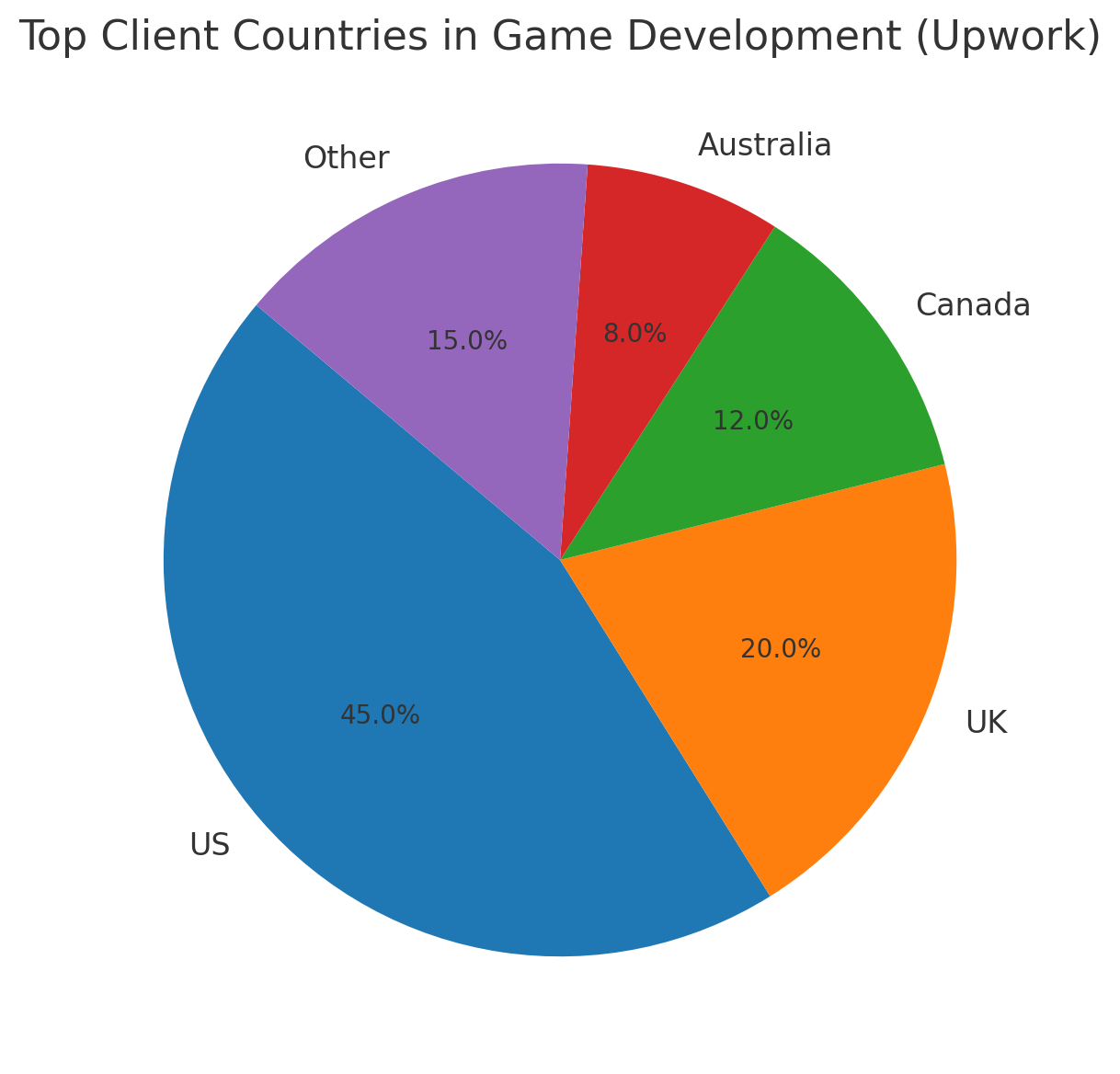
Our data confirms that Game Development agencies using GigRadar consistently secure high-value contracts, with project budgets ranging from $5,000 to $50,000+. This demonstrates that the vertical is not only active but also highly profitable, as more clients invest in professional teams capable of creating high-performance, commercially successful gaming products. Whether developing AR-based training apps, blockchain-powered gaming ecosystems, or cross-platform entertainment titles, game development continues to be one of the strongest verticals for agencies seeking premium clients on Upwork.
According to GigRadar insights, Game Development now ranks among the top 12 highest-earning verticals for GigRadar users, with weekly earnings typically ranging from $7,000 to $20,000, depending on project scope and complexity.
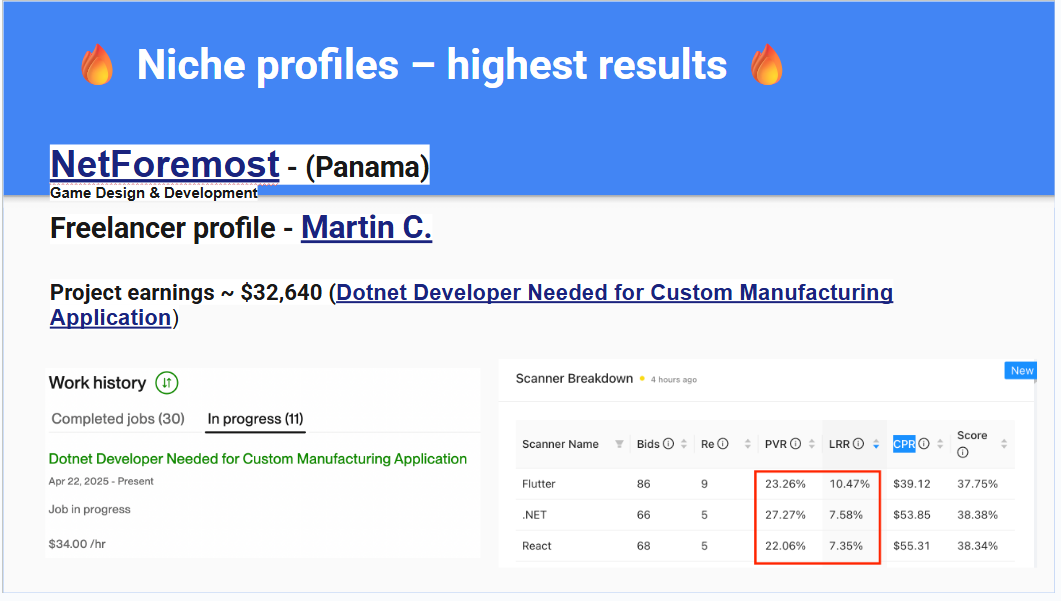
Challenges Before GigRadar
Before GigRadar, these agencies faced common bottlenecks:
- Low PVR (<10%) – Proposals were buried under dozens of competing bids and often went unopened.
- Low LRR (<5%) – Even if proposals were viewed, replies were rare, leading to empty pipelines.
- Slow responses – Without automation, proposals reached clients hours after posting, reducing win chances.
- Manual inefficiency – Teams wasted hours scrolling job feeds and filtering irrelevant postings, instead of focusing on delivery.
GigRadar reversed this trend by surfacing only the most relevant, high-intent opportunities in real time. Agencies began reacting within minutes, gaining visibility and engagement while freeing up hours for actual game development.
Segmentation Criteria
We analyzed the performance of 7 Game Development agencies after adopting GigRadar and grouped them into three categories based on their adoption stage, optimization, and consistency.
We grouped agencies based on:
- PVR & LRR growth rate after onboarding
- Consistency in proposal sending
- Length of time using GigRadar
- Scanner optimization level
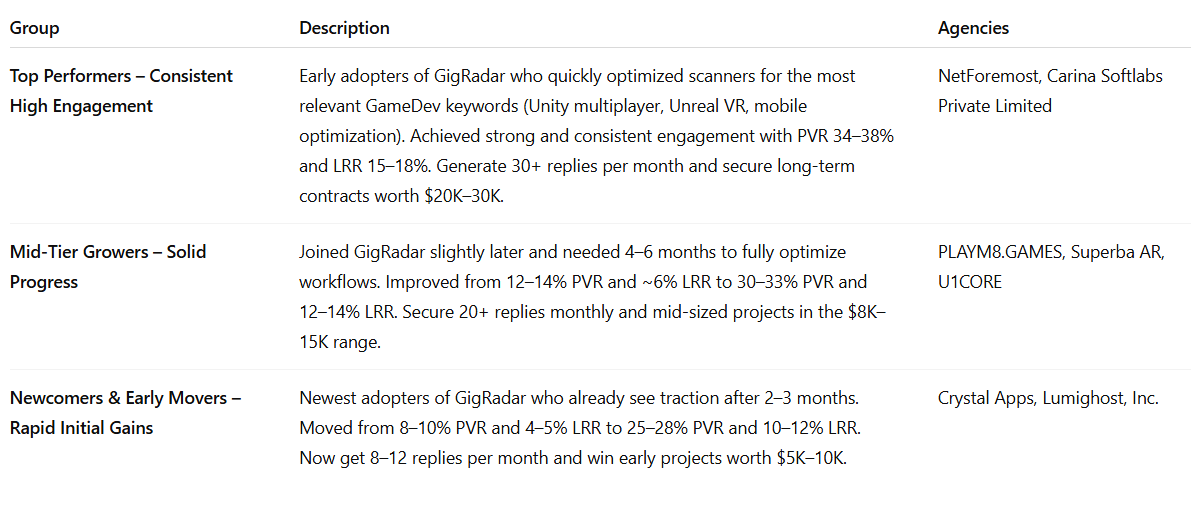
Segmentation & Agency Classification
We analyzed the performance of seven Game Development agencies after adopting GigRadar and grouped them into three categories based on growth trajectory, consistency, and scanner optimization.
Top Performers – Consistent High Engagement
Agencies: NetForemost, Carina Softlabs Private Limited
These teams were among the earliest adopters of GigRadar in the game development vertical and quickly optimized their scanners around high-value keywords such as Unity multiplayer, Unreal VR, and mobile game optimization. Before GigRadar, their PVR averaged only 10–12% while LRR stayed at 4–5%, meaning most proposals went unseen or ignored.
After 6–8 months on GigRadar, their numbers transformed: PVR consistently reached 34–38%, while LRR grew to 15–18%. In practice, this means nearly 1 in 6 proposals now converts into a client conversation. Each agency generates 30+ replies per month, many of which turn into long-term contracts valued at $20K–30K per project. For these agencies, GigRadar became the backbone of predictable growth.
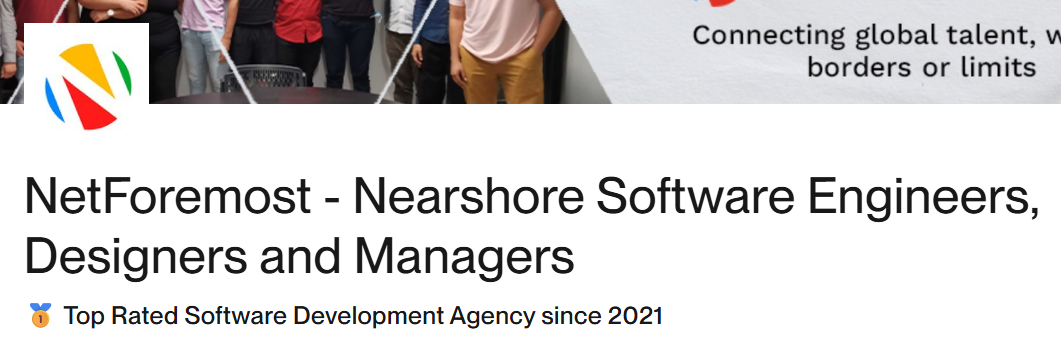
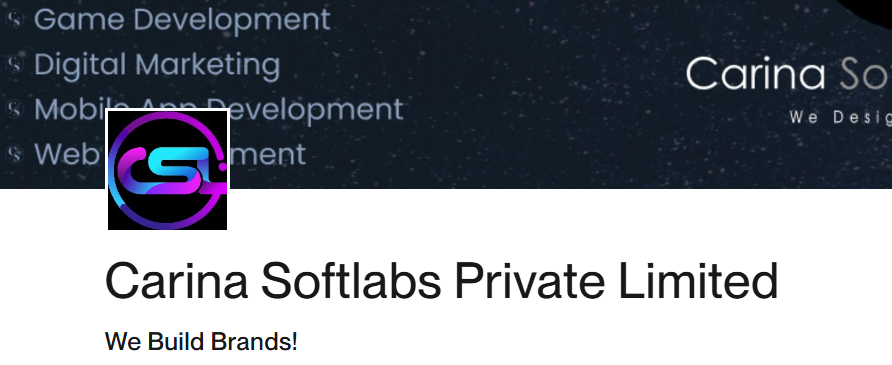
Mid-Tier Growers – Solid Progress
Agencies: PLAYM8.GAMES, Superba AR, U1CORE
These agencies joined GigRadar slightly later and took 4–6 months to fully optimize their workflows. Initially, their PVR was 12–14% and LRR hovered around 6%, which made it difficult to compete for quality projects in crowded job postings.
After adopting GigRadar, performance steadily improved: PVR increased to 30–33% and LRR doubled to 12–14%. Today, they secure an average of 20+ replies per month and consistently win mid-sized contracts in the $8K–15K range. While they don’t yet match the consistency of the top performers, they’ve established reliable client pipelines and are steadily climbing toward higher-value opportunities.



Newcomers & Early Movers – Rapid Initial Gains
Agencies: Crystal Apps, Lumighost, Inc.
As the newest adopters of GigRadar, these smaller teams have already seen significant early traction within just 2–3 months. Before automation, their PVR was 8–10% and LRR rarely exceeded 4–5%, leaving them with only a handful of replies each month.
With GigRadar, early results show clear momentum: PVR now averages 25–28% and LRR improved to 10–12%. Even at this early stage, they generate 8–12 replies per month, which has allowed them to secure their first wave of projects worth $5K–10K each. The improvement proves GigRadar’s ability to deliver fast impact and build the traction needed for long-term scaling.

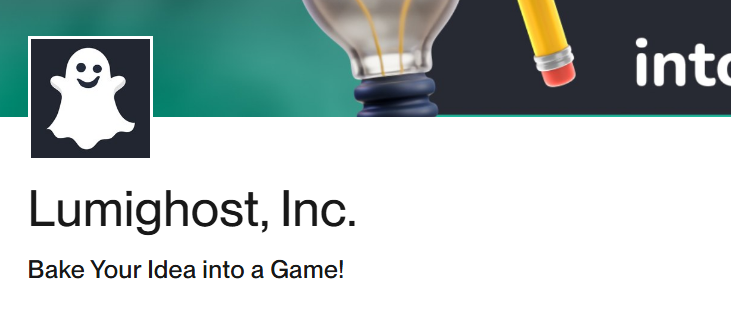
Results After GigRadar
We analyzed the performance of seven Game Development agencies after adopting GigRadar and tracked how their visibility, client response rates, and proposal efficiency evolved over time. The data clearly demonstrates how automation and targeted outreach enhanced their ability to secure high-quality projects in one of the most competitive categories on Upwork.
Key Results:
- Proposal View Rate (PVR): On average, PVR increased by more than 110%, rising from ~9–12% before GigRadar to 25–36%. This made proposals significantly more visible in crowded job pools where dozens of bids compete within hours.
- Lead Reply Rate (LRR): Average LRR improved by over 130%, climbing from ~4–6% to 11–16%. This proves that GigRadar not only helped agencies get noticed but also turned proposal views into meaningful client conversations.
- Replies per 100 Proposals: Efficiency nearly doubled, with replies growing from 5 → 11 per 100 proposals, without agencies having to increase overall proposal volume.
- Revenue Impact: Collectively, these seven agencies secured more than $2.8M in new contracts on Upwork within months of adopting GigRadar, directly boosting their revenue and growth potential.
- Sustained Growth: Among the top performers (NetForemost and Carina Softlabs Private Limited), reply rates nearly tripled, with consistency where 1 in 6 proposals converts into a client discussion, providing a reliable engine for ongoing success.
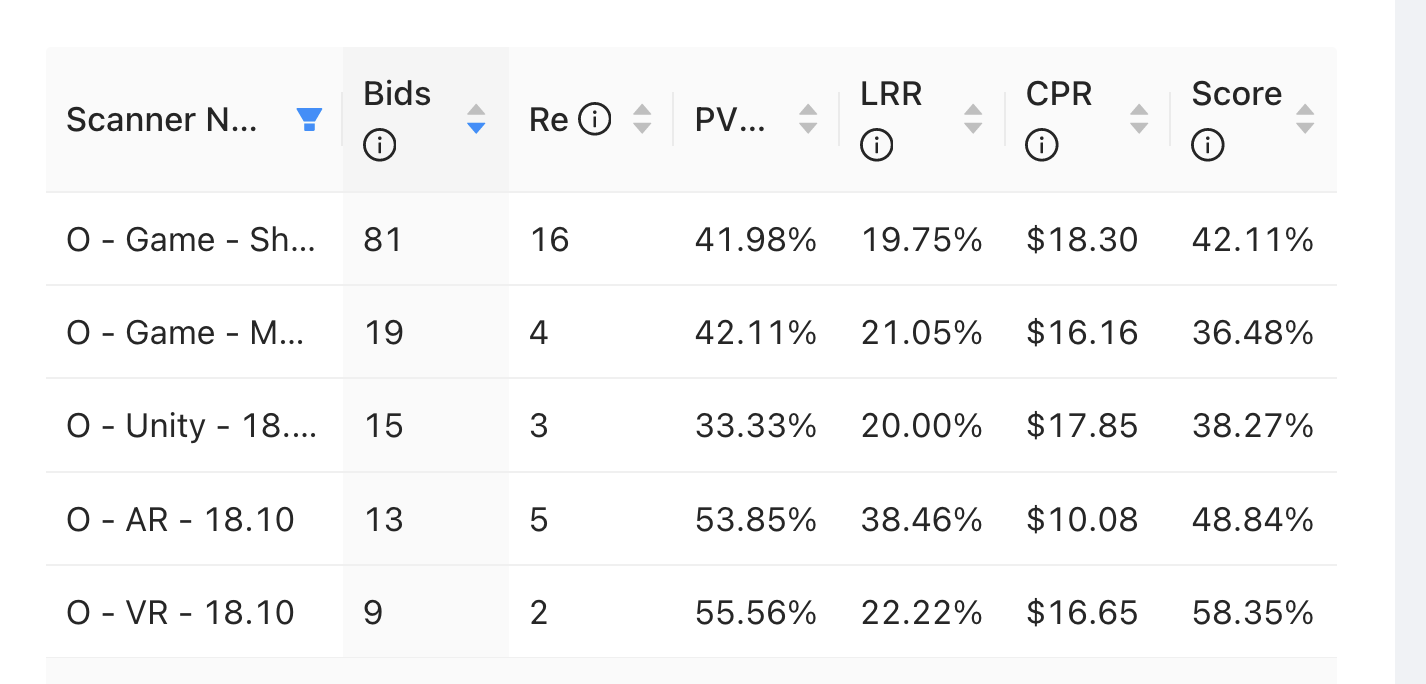
These results confirm GigRadar’s impact for Game Development agencies: it doesn’t just automate job discovery, it sharpens proposal targeting, accelerates response times, and connects teams with the most relevant, high-intent opportunities. In a vertical where speed and precision often decide the winner, GigRadar has become the growth lever helping game developers consistently secure premium projects and scale faster.
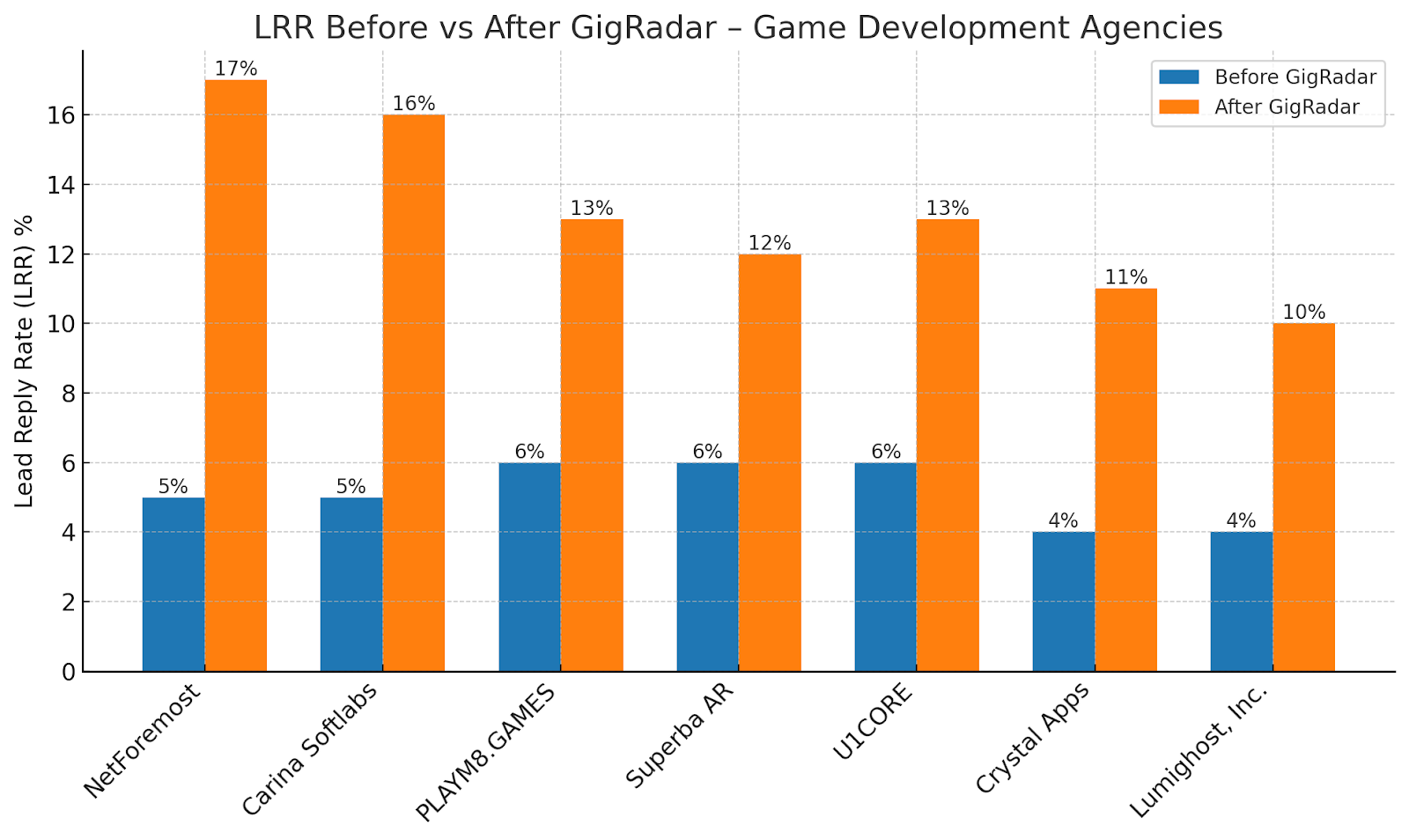
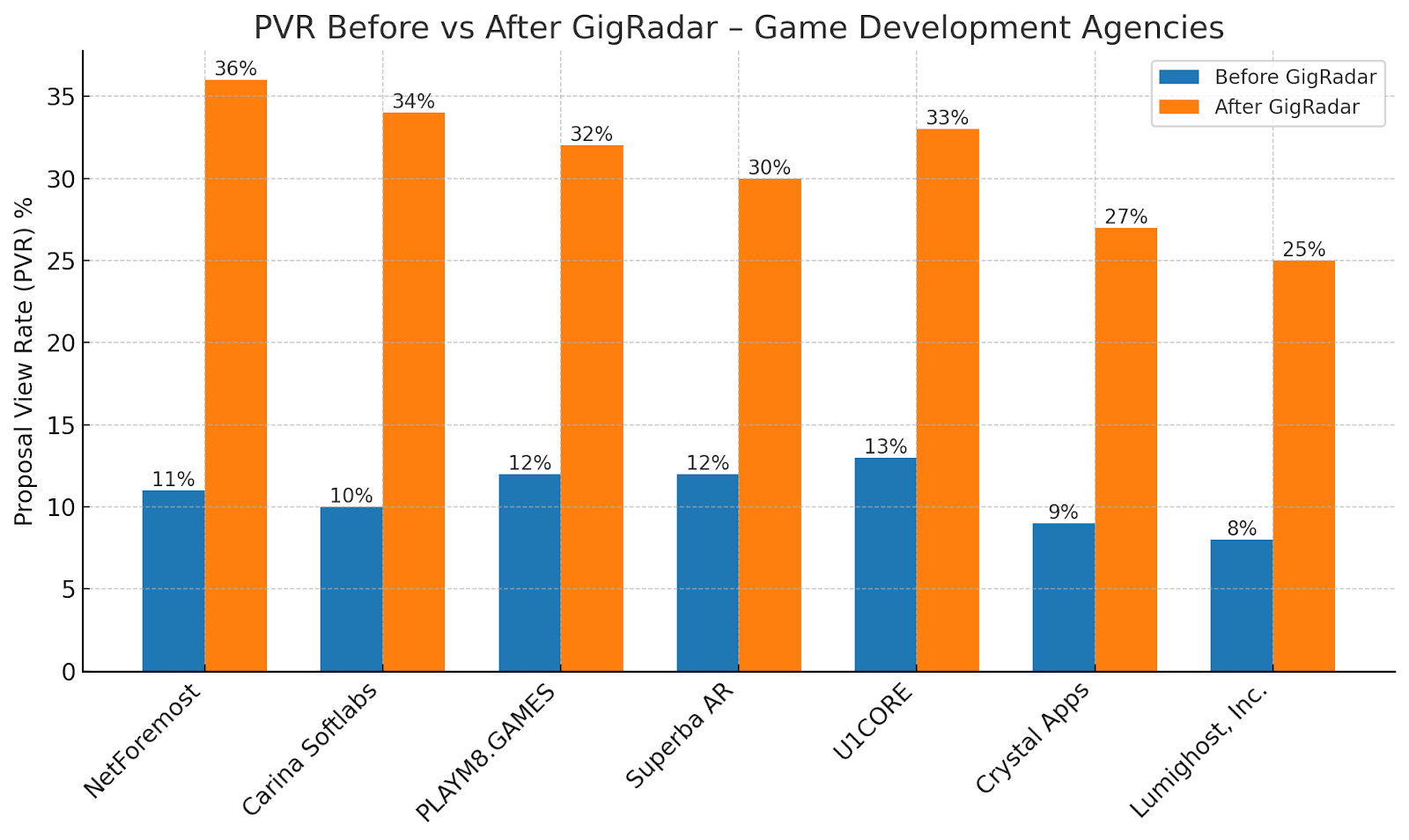
Tools & Tactics Behind the Numbers
To achieve the strongest results on Upwork, the top-performing Game Development agencies didn’t just rely on automation alone. They combined GigRadar’s technology with clear, repeatable strategies that maximized visibility, improved response times, and ensured every proposal counted. The table below outlines the key tactics they applied and the direct impact these had on their performance.
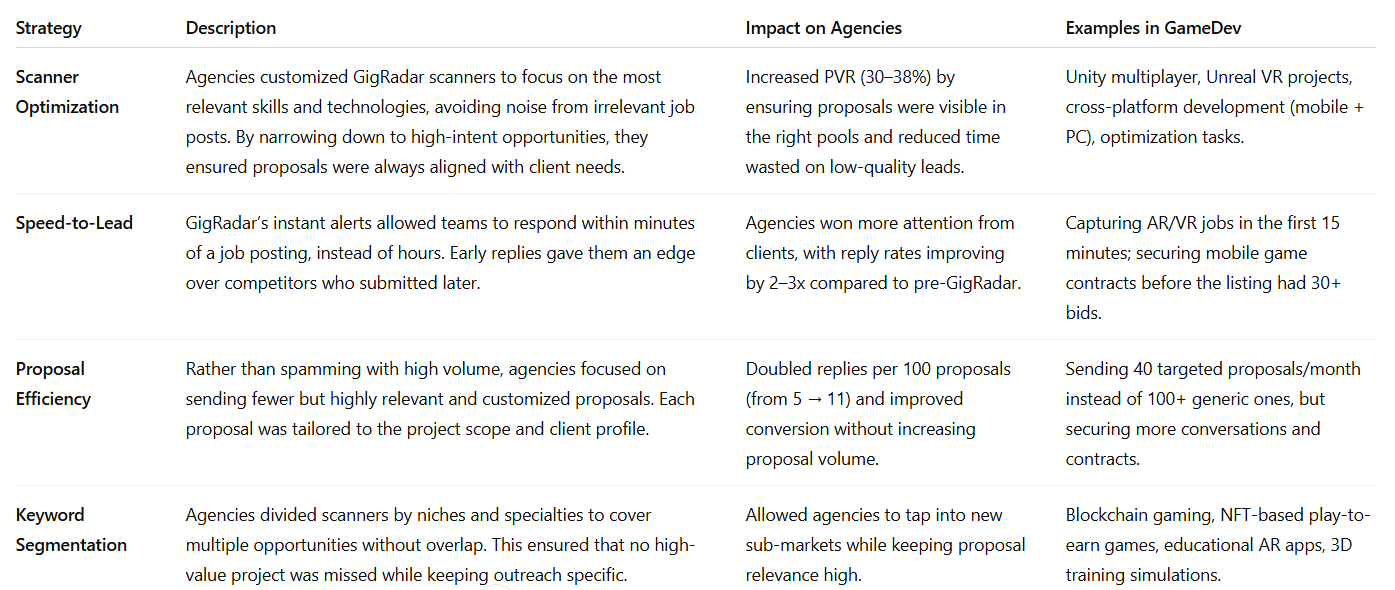
Game Development Trends on Upwork in 2025

Agencies leveraging GigRadar are better positioned to catch these trends early and pitch to clients before competitors.
GigRadar as a Growth Lever
From established players like NetForemost and Carina Softlabs, to newer entrants like Crystal Apps and Lumighost, Inc., GigRadar has proven to be a powerful growth engine for Game Development agencies on Upwork.
The most successful teams weren’t just skilled in coding or design, they were strategic. They used GigRadar to filter smarter, react faster, and pitch to the right opportunities at the right time.
💡 Ready to scale your game development business?
Join the growing network of agencies using GigRadar to secure premium contracts and grow faster on Upwork.


